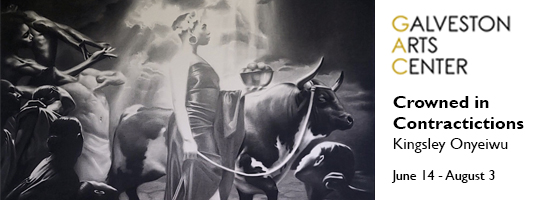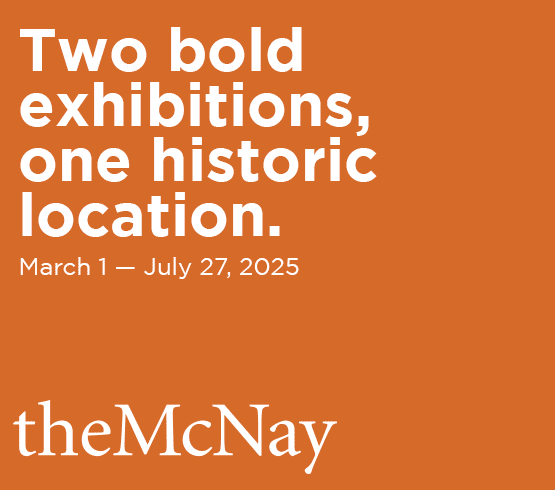“I consider myself a bit of a late bloomer,” artist Michelle Cortez Gonzales tells me from her home studio in Fort Worth. “I didn’t even enter a museum until undergrad, and that’s where I learned about the Chicano movement and other art movements that influenced me. It sparked a love for and curiosity about my culture and heritage.”
“Working with my hands through traditional domestic practices allows me to open myself to dialogue with my ancestors and to receive memory, connection, and healing. It provides some comfort, whether for my family or for me,” she says. “Comfort is important in my work, it’s like finding a space where you’re allowed to be soft.”
Initially she experimented with fabric, specifically lace from her grandmother. Today Gonzales uses additional materials such as patterned fabrics like tablecloths or bed sheets, plus picture frames and chairs—objects that are associated with home and comfort and that represent personal relationships. Her overall desire is to connect with her family and her culture, to others and to herself, through art. And she is well on her way to doing just that with solo and group exhibitions throughout the state at Presa House Gallery in San Antonio, Anya Tish in Houston, and 500X in Dallas, among others.
Gonzales subtly draws attention to imagery recognizable as Mexican American by using vivid colors, lace, and flora. She also includes hidden or veiled figures and images of the cactus, a symbol of strength and endurance. For example, in Hasta La Raíz, a lace curtain sewn onto the canvas drapes a painted flower tree branch, above which a shadowy face is barely visible. The Load depicts a woman, partially obscured, hanging laundry on a clothesline. In each painting, the artist’s soft layering of colors and fabrics create an ethereal, almost ominous, effect.
As we talk, I ask Gonzales if it’s important for her to make artwork that is identifiable as Mexican American. “I often think about my work not being culturally representational enough or being too ambiguous,” she says, “and that’s the reality of my experiences and the deeper conversation I hope my work is speaking to. The struggle to belong, the complex familial relationships and to loss in general, whether it’s cultural, physical, or spiritual.”
That complexity reveals itself in part through a blending of elements, figuring out how they work together and how they speak to each other. She says that she’s “always trying to work or think outside of the square,” explaining further that installations and sculpture let her do things that aren’t possible with painting.

1 ⁄8
Michelle Cortez Gonzales in her studio. Photo courtesy of the artist.

2 ⁄8
Michelle Cortez Gonzales, The Load, sewn fabric, acrylic, oil, 36 x 24 in, 2023

3 ⁄8
Michelle Cortez Gonzales, Tethered, fabric, poly-fil, chair, paint, sheetrock, wood, dirt, 7 x 6 ft., 2022

4 ⁄8
Michelle Cortez Gonzales, Silent Knowledge, resin, mylar, graphite, wood, paint, sewn fabric, various sizes. Photo by Melissa Gamez Herrera, 2023.

5 ⁄8
Michelle Cortez Gonzales, Passable Impassable Roles, sewn fabric acrylic, oil, polyfil, 48 x 60 in. 2022

6 ⁄8

7 ⁄8
Michelle Cortez Gonzales, Hasta La Raiz, sewn fabric, acrylic, oil, polyfil, 60 x 48 x 3in. 2022

8 ⁄8
Michelle Cortez Gonzales, Presence Through Absence, concrete, metal pole, fabric, embroidery thread, clothes pins, sod, soil, rope, 7 x10 ft. 2022
“I had no access to conversations about how or why my family rarely talked about their past; about loss, familial connections,” says Gonzales. “Now as an adult, my journey of connecting to my roots also becomes about acknowledging the psychological and emotional effects of their experiences. Histories can become forgotten when we don’t have the stories or pride to pass down. As a result, we lose our connection with each other and separate ourselves from the discrimination that is still happening today. The political climate in America now continues to challenge cultural preservation and we see history potentially unfolding all over again.”
For Presence Through Absence, Gonzales embroidered fabrics with words like la familia, tradición, and historia and hung them from a double clothesline that blocks off a corner of the gallery. A blue skirt striped with lace, lying in the grass, reveals the word yo. The installation resonates with feelings of tenderness, care, and even exhaustion alongside physical elements of identity and displacement.
Additionally, Gonzales was awarded the 2023 NEA Challenge America Grant, distributed by Dallas District Colleges, and she was recently awarded a small grant to attend the Vermont Studio Center in 2024. All of this attention is bound to launch her outside of her comfort zone. But Gonzales says she’s up for the challenge. “Right now, I’m working and trying to be in the present moment. So whatever comes my way, I’ll be open to it.”
—NANCY ZASTUDIL




